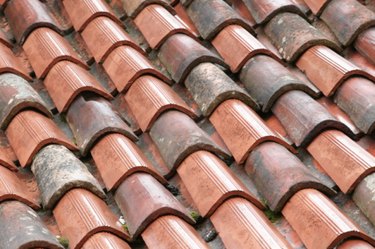
Clay tile is a historic roof material made from kiln-baked molded clay, usually earthenware. This material is normally unglazed, but may be glazed or coated with other materials to produce a colorful finish. Clay tile roofs are most commonly used in warm climates without freeze-thaw cycles that can degrade the tiles. These tiles' breathable structure, thermal mass and unique shape allows them to keep homes cooler than asphalt shingles and many other roofing materials.
Solar Reflectiveness
Video of the Day
Clay tiles reflect more sunlight than conventional asphalt roofs, though their reflectiveness varies by color. Unglazed red terracotta clay tile reflects 33 percent of the solar energy that strikes its surface. This gives it a rating of 36 on the Solar Reflectance Index, according to the E.O. Lawrence Berkeley National Laboratory. White glazed clay tile reflects 70 percent to 80 percent of sunlight that reaches its surface. By comparison, conventional dark asphalt shingles reflect 5 percent to 15 percent of sunlight and reflective white asphalt shingles reflect 35 percent to 55 percent.
Video of the Day
Air Flow
Tile roofs are attached using pegs or nails through the upper edge of the tile, holding them to a wooden support. This attachment method allows free air flow both over and under the tiles, especially in high-profile Spanish tile. Better air flow means the tile can disperse heat more quickly and efficiently. Clay roof tiles disperse 70 percent less heat into the house during the summer months than asphalt shingles, according to "Western Roofing" magazine. Air space beneath the tile also provides insulation in the winter, keeping homes warm during cold weather.
Thermal Mass
Thermal mass refers to a material's ability to absorb heat and radiate it later. Clay is considered a high thermal mass material. It heats up slowly and disperses heat slowly, keeping homes with clay tile roofs at a relatively even temperature. This feature allows the roof to release heat absorbed during the day over the course of the night, when temperatures are cooler, rather than immediately, the way metal roofs or asphalt tend to.
Considerations
Clay tile isn't the only material that reflects sunlight, provides good air flow, insulation and has high thermal mass. Other solar-reflective materials include white or unpainted metal, white concrete tile and white fiber-cement shingles. Concrete and slate roofs also have high thermal mass, storing heat slowly and releasing it over time. Any tile roofing installed using the same techniques as clay will provide similar air flow properties and an insulating layer of air under the roof. Some materials, such as concrete and fiber-cement, work better in cold climates than clay.
- National Park Service; The Preservation and Repair of Historic Clay Tile Roofs; Anne E. Grimmer and Paul K. Williams
- National Roofing Contractors Association: Clay Tile and Concrete Tile
- “Western Roofing Magazine”; Cool Clay Tile; Lyla Lawry; January/February 2007
- Energy End-Use Forecasting: Low and High Solar-Reflectance Options for Typical Roofing Materials